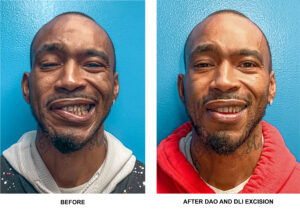About UNC Facial Nerve Center
RESTORING FACIAL FORM AND FUNCTION
Facial movements are highly coordinated and complex. Facial expressions allow people to display emotions and communicate with others. The facial nerve (aka cranial nerve VII) controls all muscles of facial expression. There are many branches of the facial nerve that spread out across the face and allow people to smile and make other facial expressions. These branches also allow people to close and protect their eyes, and contribute to other facial functions such as speech, nasal breathing, drinking, and chewing.
Facial Paralysis Treatment at UNC Facial Nerve Center
Facial paralysis occurs after injury to one or more branches of the facial nerve and can result in facial asymmetry and difficulty expressing emotions. Patients can have trouble with protecting their eye, chewing, speech, and nasal breathing. Facial paralysis can lead to depression, anxiety, and losing interest in being around other people.
Bell’s palsy is the most common cause of facial paralysis and is thought to result from reactivation of herpes simplex virus, a virus which nearly all adults carry. Other common causes of facial paralysis include Ramsay Hunt syndrome (Herpes Zoster virus, the same virus that causes Shingles), vestibular schwannoma (aka acoustic neuroma) surgery, benign tumors, cancer, Lyme disease, trauma, ear surgery, parotid surgery, and congenital disorders. Diagnosing the cause of facial paralysis is critical to providing patients with the right treatment.
At the UNC Facial Nerve Center, we currently take care of patients with more than 15 different causes of facial paralysis. No matter the cause or how long you have had facial paralysis, Dr. Miller will work with you to improve your facial symmetry and function.
Regardless of the cause, the most immediate consideration is protection of the eye. Without the ability to effectively close the eye, patients can develop eye irritation, dryness, and the feeling that there is “sand in the eye,” a harbinger of potentially dangerous problems with the eye. Eye drops, ointments, and gels help patients moisturize and protect their eyes. The eye can also be taped shut at night if patients have irritation when awakening in the morning. There are several procedures that may be able to help with closure of the eye. Our surgeons are among the world’s experts in managing this paralytic eyelid syndrome (PES).
Smiling is perhaps the most important form of human communication. Not only does smiling let other people know you are happy, but research shows smiling also makes you feel happy! Management of smile and facial asymmetry and lack of spontaneous movement is managed by various techniques including targeted facial physical therapy, chemodenervation (aka Botox), and surgery. The UNC Facial Nerve Center offers the most cutting-edge procedures to get patients smiling again.

Dr. Miller’s Facial Paralysis Recovery
Dr. Matthew Q. Miller received specialized training at Harvard Medical School in comprehensive management of facial paralysis. Dr. Miller himself had facial paralysis after a bicycling accident:
“During my recovery, I experienced firsthand how facial paralysis takes away our ability to express ourselves and our ability to communicate effectively. People often ignore what patients with facial paralysis are saying because they’re left wondering why they cannot make normal facial expressions; it can leave patients depressed and socially isolated. This experience has really motivated me to take care of facial paralysis patients, to help restore facial form and function.”
At the UNC Facial Nerve Center, each patient is carefully assessed by Dr. Miller and his team to determine the cause of his or her facial paralysis and determine the best treatment options. Each patient presents a unique anatomic picture and requires a different set of tools for optimal, natural facial reanimation. YOUR TREATMENT WILL BE CUSTOMIZED TO YOUR CONDITION AND GOALS. WE WILL WORK WITH YOU TO HELP RESTORE FACIAL FORM AND FUNCTION!